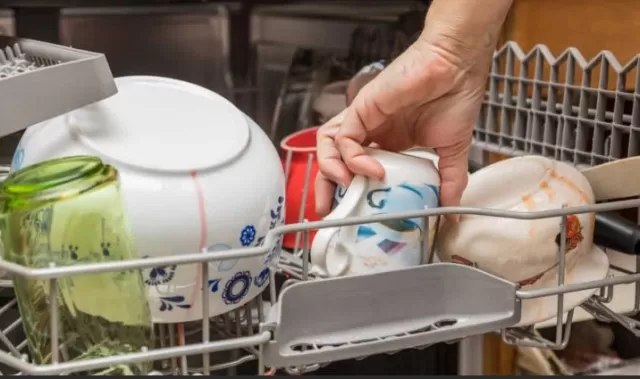Bug-Friendly Kitchen: Mistakes that Attract Unwanted Guests. If you desire a kitchen that is free from pests, cleanliness should be your top priority. By minimizing crumbs and food waste, you can significantly deter insects and increase your success in keeping them out. To achieve a pest-free kitchen, make sure to avoid these careless mistakes
Minimizing Dishwasher Usage: The Consequences of Infrequent Operation

Despite pre-rinsing dishes prior to loading them into the dishwasher, remnants of food are often left behind, attracting pests.
While dishwashers are designed with tight seals to prevent water leakage, it proves no challenge for small insects to infiltrate the machine. As a result, infrequent use of dishwashers can lead to unforeseen issues and unwelcome encounters with bugs.
The Hazards of Neglecting Dirty Dishes in the Sink
Allowing a sink full of Dirty Dishes to accumulate creates an enticing feast for bugs and insects.
Delaying the task of washing dishes should be avoided at all costs. It is crucial to promptly clean every plate, pot, and pan immediately after each meal to prevent the kitchen from becoming a magnet for an infestation of unwanted pests. By prioritizing timely dishwashing, you can effectively thwart the invasion of insects in your kitchen space.
Rethinking the Suitability of Cardboard Boxes for Storage

While cardboard boxes serve their purpose well in the realm of deliveries, relying on them for storage can lead to undesirable consequences.
Due to their corrugated structure, these boxes offer numerous crevices and tiny gaps that provide an ideal breeding ground for cockroaches and various other insects. The hatching of these eggs within the confines of your home can swiftly escalate into a troublesome situation, resulting in an influx of unwanted pests.
It is advisable to promptly dispose of cardboard boxes in the recycling bin once their contents have been unloaded to prevent potential infestations and maintain a pest-free environment.
The Importance of a Crumb-Free Table: Preventing Bug Infestations
After clearing the dishes and placing them in the dishwasher, it is crucial to diligently wipe down tables, leaving no traces of crumbs behind.
The presence of even the tiniest crumbs serves as an enticing food source for a wide range of insects. By ensuring a thorough cleaning of the table surface, you can effectively eliminate potential nourishment for bugs, thereby reducing the risk of attracting and fostering an infestation in your living space. Adopting this simple practice contributes to maintaining a clean and pest-free environment.
The Significance of Properly Sealing Food: Warding off Unwanted Insects

Allowing food items such as cereals, crackers, pasta, rice, and even bagged flour and sugar to remain unsealed poses a significant risk of attracting bugs.
Open containers provide an easy entry point for insects seeking nourishment. To minimize this risk, it is advisable to take simple precautions.
At the very least, roll down the interior bag of these items a few folds and secure it with a clothespin or chip clip. For loose grains, flour, and sugars, it is best to store them in airtight canisters or containers.
In addition to maintaining a clean kitchen, implementing extra measures to protect your stored food can further deter unwanted insects and maintain its quality. One effective method is to seal opened bags inside large zip-lock bags, providing an additional layer of protection. Here’s how this simple yet effective technique can help you:
- Secure Opened Bags: When you have partially used bags of food such as cereal, snacks, or grains, transfer them into large zip-lock bags. Make sure to remove as much air as possible before sealing the bags tightly.
- Create a Barrier: The zip-lock bag acts as a barrier, preventing insects from accessing the contents of the opened bag. It significantly reduces the chances of pests infiltrating your stored food, especially those that can chew through flimsy packaging.
- Maintain Freshness: By sealing the bags tightly, you also help maintain the freshness and quality of the food. This added protection can prolong its shelf life and reduce the likelihood of spoilage.
- Easy Identification: Transparent zip-lock bags allow you to easily identify the contents without having to open them. This saves you time and minimizes the potential for spills or messes in your pantry.
- Stack and Organize: Zip-lock bags provide a more compact and organized storage option. They enable you to stack the bags neatly, maximizing your pantry or cabinet space and making it easier to locate specific items.
Remember, while zip-lock bags provide an additional layer of protection, it’s still crucial to keep your kitchen clean and address any potential pest attractants. Regularly inspect and clean your pantry, dispose of expired items, and ensure proper sealing of all food containers.
By implementing these measures, including the use of zip-lock bags for opened food packages, you can effectively deter pests, maintain the quality of your stored food, and reduce the risk of encountering an infestation. Enjoy peace of mind knowing that your food is securely protected and your kitchen remains pest-free.
*The information is for reference only.